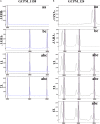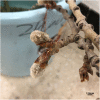Effects of Colchicine on Populus canescens Ectexine Structure and 2n Pollen Production
- PMID: 32256514
- PMCID: PMC7092626
- DOI: 10.3389/fpls.2020.00295
Effects of Colchicine on Populus canescens Ectexine Structure and 2n Pollen Production
Abstract
Triploid breeding is a central way to improve growth traits, timber quality, and stress resistance in Populus. In the present study, the morphology and viability of colchicine-induced 2n pollen, triploid production by crossing induced 2n pollen, and identification of genetic constitution of colchicine-induced 2n pollen were conducted in Populus canescens based on optimizing technology for inducing chromosome doubling in pollen. We found that the meiotic stage, injection time, and the interaction between the meiotic stage and injection time had highly significant effects on the 2n pollen production rate. The most effective treatment for inducing 2n pollen was to give 11 injections of 0.5% colchicine solution when pollen mother cells (PMCs) were at the pachytene stage. The highest 2n pollen production rate was 30.27 ± 8.69%. Colchicine occasionally affected ectexine deposition, and some narrow furrows were detected in the ectexine structure. However, no significant difference was observed in the pollen germination rate between natural 2n pollen and colchicine-induced 2n pollen. Moreover, 5 triploids derived from FDR-type 2n pollen were generated by crossing induced 2n pollen, suggesting that colchicine does not eliminate the function of colchicine-induced 2n pollen. However, slower growth of 2n pollen tubes was responsible for a lower triploid production rate.
Keywords: 2n pollen viability; Populus canescens; chromosome doubling; colchicine; triploid.
Copyright © 2020 Zhou, Wu, Sang, Zhao, Zhang and Liu.
Figures








Similar articles
-
High temperature exposure did not affect induced 2n pollen viability in Populus.Plant Cell Environ. 2018 Jun;41(6):1383-1393. doi: 10.1111/pce.13165. Epub 2018 Apr 20. Plant Cell Environ. 2018. PMID: 29430685
-
Gibberellins as a novel mutagen for inducing 2n gametes in plants.Front Plant Sci. 2023 Jan 11;13:1110027. doi: 10.3389/fpls.2022.1110027. eCollection 2022. Front Plant Sci. 2023. PMID: 36714757 Free PMC article.
-
Induction of 2n pollen with colchicine during microsporogenesis in Phalaenopsis.Breed Sci. 2022 Sep;72(4):275-284. doi: 10.1270/jsbbs.21100. Epub 2022 Aug 26. Breed Sci. 2022. PMID: 36699823 Free PMC article.
-
Exploitation of induced 2n-gametes for plant breeding.Plant Cell Rep. 2014 Feb;33(2):215-23. doi: 10.1007/s00299-013-1534-y. Epub 2013 Dec 6. Plant Cell Rep. 2014. PMID: 24311154 Review.
-
Breeding polyploid Populus: progress and perspective.For Res (Fayettev). 2022 Mar 31;2:4. doi: 10.48130/FR-2022-0004. eCollection 2022. For Res (Fayettev). 2022. PMID: 39525419 Free PMC article. Review.
Cited by
-
In vitro induction of tetraploidy and its effects on phenotypic variations in Populus hopeiensis.BMC Plant Biol. 2023 Nov 13;23(1):557. doi: 10.1186/s12870-023-04578-0. BMC Plant Biol. 2023. PMID: 37957587 Free PMC article.
-
In vitro octaploid induction of Populus hopeiensis with colchicine.BMC Plant Biol. 2022 Apr 6;22(1):176. doi: 10.1186/s12870-022-03571-3. BMC Plant Biol. 2022. PMID: 35387617 Free PMC article.
-
Advances and Perspectives for Polyploidy Breeding in Orchids.Plants (Basel). 2022 May 27;11(11):1421. doi: 10.3390/plants11111421. Plants (Basel). 2022. PMID: 35684197 Free PMC article. Review.
-
Two Is Company, but Four Is a Party-Challenges of Tetraploidization for Cell Wall Dynamics and Efficient Tip-Growth in Pollen.Plants (Basel). 2021 Nov 5;10(11):2382. doi: 10.3390/plants10112382. Plants (Basel). 2021. PMID: 34834745 Free PMC article. Review.
-
Exploiting Unreduced Gametes for Improving Ornamental Plants.Front Plant Sci. 2022 Jun 6;13:883470. doi: 10.3389/fpls.2022.883470. eCollection 2022. Front Plant Sci. 2022. PMID: 35734261 Free PMC article. Review.
References
LinkOut - more resources
Full Text Sources

